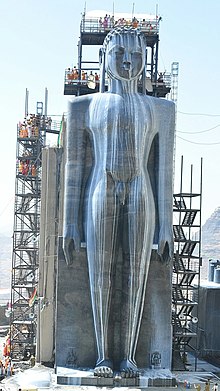Panchamrita
Panchamrita (lit. five Amṛtas in Sanskrit) is a mixture of five foods used in Hindu as well as Jain worship and puja and Abhiṣeka which are usually honey, liquid jaggery, cow milk, curd and ghee.[1] [2] After pachamrita is used in puja and abhisheka, it is distributed as prasad.[3]

Preparation
Panchamrita is prepared by mixing cow milk, curd, honey, jaggery, and ghee. However, there may be certain regional variations in ingredients. Most south Indians add ripe banana[4] as well. Panchamrita is an Ayurvedic preparation but has been manipulated in several places to cut costs and increase keeping value.
Some people use sugar instead of jaggery, which is not accepted by all, as sugar is not a natural element like jaggery and sugar is sometimes refined using bone charcoal which makes it inappropriate to use for pooja.
In Palani Murugan temple, Tamil Nadu, panchamrita consists of banana, sugar, ghee, honey, seedless dates, cardamom and sugar candy.[5] The banana used is the Virupatchi variety, which grows only in the Palani hills and has very low water content.[6]

Keralites may also include tender coconut. Some recipes also include grapes.[7]
Usage
- It is used as an offering during poojas.
- It is used as a libation during Abhisheka.
- It is also used as a skin cleanser.
- It was introduced into the practice of African American hoodoo folk-magic by the occult writer Henri Gamache during the 1940s.[8]
References
- For definition of पञ्चामृत (IAST: pañcāmṛta ) as "the collection of five sweet things used in worshipping deities" see: Apte 1965, p. 578,
- Delamaine, James (1826). "Of the Sra'wacs or Jains". Transactions of the Royal Asiatic Society of Great Britain and Ireland. 1 (2): 413–438. ISSN 0950-4737.
- "Happy Mahashivratri 2018: Importance Of Panchamrit And How To Make It At Home". NDTV.com. Retrieved 5 March 2020.
- Karigoudar, Ishwaran (1977). A populistic community and modernization in India. Books.google.com. ISBN 9004047905. Retrieved 23 May 2009.
- "Archived copy". Archived from the original on 14 July 2018. Retrieved 22 December 2016.CS1 maint: archived copy as title (link)
- "Palani temple to double panchamritam production". Economic Times. Palani, India. 6 October 2009.
- Nair, K.K. (26 March 2007). Sages Through Ages, Proof of divinity given. Books.google.com. ISBN 9781418446895. Retrieved 23 May 2009.
- Millett, Deacon (2013). Hoodoo Honey and Sugar Spells: Sweet Love Magic in the Conjure Tradition. Lucky Mojo Curio Co. ISBN 978-0-9719612-4-1.
- Apte, Vaman Shivram (1965), The Practical Sanskrit Dictionary (Fourth revised and enlarged ed.), Delhi: Motilal Banarsidass Publishers, ISBN 81-208-0567-4